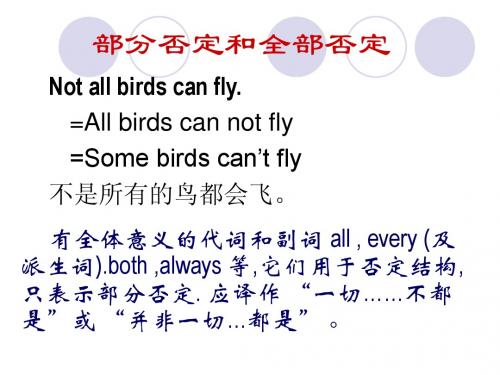英语全部否定和部分否定的巧译
- 格式:doc
- 大小:26.00 KB
- 文档页数:3

英语否定的几种表示方法英语中的部分否定(即不完全否定),接下来,小编给大家准备了英语否定的几种表示方法,欢迎大家参考与借鉴。
英语否定的几种表示方法一、 all 的否定式:not all…(或:all…not)表示"并非都……"、"不是所有的都……"例如:Not all men can be masters. (= All men cannot be masters.) 并非人人都能当头头。
Not all bamboo grows tall. 并非所有的竹子都会长得很高。
二、 both 的否定式:not…both (或:both… not) "并非两个……都……" 例如:I don't want both the books. 我不是两本书都要。
Both (the) windows are not open. 两扇窗子并不都开着。
三、every…的否定式:"不是每……都……" 例如:Not every book is educative. (或:Every book is not educative.) 不是每本书都有教育意义的。
Not everyone likes this book. 并非人人都喜欢这本书。
This flower is not seen everywhere. 这花并不是随处可见的。
四、 always的否定式:"并非总是(并非一直)……" 例如:He is not always so sad. 他并不是一直都这样悲伤。
五、 entirely1, altogether, completely2 和quite 的否定式:"不完全……","并非完全……" 例如:The businessman is never to be entirely trusted. 不可以完全信任商人。



初中英语中必须掌握的八种否定形式一、完全否定英语中的完全否定可以用not, no, never, none, nobody, nothing, neither...nor, nowhere 等表示。
如:1.Nothing is difficult for him.没什么难得到他。
2.Mary never has beef.玛丽从来不吃牛肉。
3.Neither answer is correct.两种答案都不对。
二、部分否定英语中表示“全体〃意义的代词,形容词或副词。
如:all, both, altogether, always, completely, every day, everyone, everything, everywhere, every, everybody, many, often 等与not 搭配时,通常表示部分否定,意思是“并非都是〃“不完全是〃“不是每个都是〃等。
例如:1.Not everyone was amused by these April FooPs jokes.并不是每个人都觉得这些玩笑有趣。
2.Food likes and dislikes do not always seem related to nutrition. 对食物的好恶似乎并不总与营养有关。
比较:Nothing makes him happy.(全部否定)没有哪一件事情让他开心。
Not everything makes him happy.(部分否定)并不是每一件事都让他开心。
None of the students went to visit the science museum last week. (完全否定)上周没有一个学生去参观科技博物馆。
Not all of the students went to visit the science museum last week. (部分否定)上周并不是所有的学生都去参观了科技博物馆。

英语中的否定形式非常灵活,是一个常见而又较复杂的问题,被认为是英语学习者的一大难点。
有的句子在在形式上是肯定而实质上却是否定,有的则形式上是否定而实质上是肯定,这给学生的理解和翻译造成了很大的困难。
翻译否定句,首先要弄清楚否定结构用法的特点,否则就容易出错。
英语中的否定可分为明否定(包括全部否定、部分否定和双重否定)和暗否定(即含蓄否定)。
这里就以上提到的几种否定结构谈谈翻译上的技巧:一、全部否定(Complete Negation)全部否定是指将句子否定对象加以全盘、彻底地否定。
常用的全部否定词与习惯用语有:not,no,none,never,nobody,nothing,neither…nor,nowhere,no one,etc. 只要使用上述否定词,都是具有全部否定意义的句子。
翻译成中文时,一般把全部否定词照翻即可。
例:He is not a translator.他不是翻译。
This problem is so difficult that none of us can solve it.这个问题太难,我们当中没人能解决。
※需要注意的是,根据句子的意思和中文习惯否定成分有时会发生转换,即否定转移现象。
由think,reckon,consider,feel,believe,hope,suppose,expect,fancy,fear,trust等构成的否定句,形式上否定主句的谓语,而意义上否定从句的谓语。
英译汉时,要把否定转移到从句上。
I don’t think that he can operate the new electronic computer.我认为他不会操作这台新型电子计算机。
I don’t imagine that taxes will be reduced this year.我认为今年不会降低税收。
二、部分否定(Partian Negation)部分否定在英语句子中是对some,all,both,every,many,much,always,often等词的否定,不论否定词“ not”放在这些词的前面,还是同句中谓语一起构成否定式谓语,都属于部分否定。

部分否定与全部否定让我们先看下面两个句子:( 1 )All my friends do not know English.我的朋友并不是都懂英语。
( 2 )None of my fiends know English.我的朋友没有一个懂英语。
句( 1 )中的all … not相当于“ not all ”,意思是“并非全部”。
这就是所谓的“部分否定”。
此句也可改写为:Not all my friends know English.句( 2 )中的none 是与all not 相对应的全部否定,在英语中涉及部分否定的词语除all外还有the whole, both, everybody, everything, always, everywhere 等。
现将常见的一些词或词组的部分否定与全部否定对照关系举例如下:1. not all (some )和none, no one, no …a. Not all birds can fly.不是所有的鸟都会飞。
(部分否定)没有一只鸟会下棋。
(全部否定)2. not the whole (some )和not anya. He hasn't paid the whole amount.他并未付清全部款项。
(部分否定)b. He hasn't paid any of the money.这笔钱他分文未付。
(全部否定)3. not both (the one or the other )和neither ,not … eithera. I cannot promote either of you.你们两位我不能都提升。
(部分否定)b. I cannot promote either of you.你们两位我都不能提升。
(全部否定)4. not everybody (some people )和nobodya. Not everybody can do the same.并非每个人都能同样这么做。
英语(yīnɡ yǔ)否定句翻译一、全部否定(Complete Negation)全部否定是指将句子否定对象加以全盘、彻底地否定。
常用的全部否定词与习惯用语有:not, no, none,never, nobody, nothing,neither…nor, nowhere,no one, etc. 只要使用上述(shàngshù)否定词,都是具有全部否定意义的句子。
翻译成中文时,一般把全部否定词照翻即可。
例:He is not a translator.他不是(bù shi)翻译。
This problem is so difficult that none of us cansolve it.这个问题太难,我们(wǒ men)当中没人能解决。
二、部分(bù fen)否定(Partial Negation)部分否定在英语句子中是对some, all, both,every, many, much, always, often等词的否定,不论否定词“ not”放在这些词的前面,还是同句中谓语一起构成否定式谓语,都属于部分否定。
可译为:“并非所有的都”;“并不全是”;“不一定总是”。
例:All that glitters is not gold. (=Not all that glitters is gold.) 闪光的东西不一定(yīdìng)都是金子。
Both of the instruments are not precision ones. (=Not bothof the instruments are precision ones.)这两台仪器(yíqì)并不都是精密仪器。
从以上两例可看出,not every=some, not both=one, not always=sometimes,not wholly=in some degree not together=somewhat.三、双重否定(Double Negation)双重否定是指两个否定词并用,否定同一个单词,或者一个否定词否定另一个否定词,其否定意义互相抵消得到肯定意义。
由于英语和汉语的语法习惯差异,含有否定意义词的相关句型在翻译和具体含义理解上是一大难点。
下面小编就翻译时比较常见的关于否定句的误区来详细解释一下~(一)部分否定和全部否定1,部分否定,当not出现在含有表示全部肯定的不定代词(all,every-,both等)时,不管是之前还是之后,即表示整体中的一部分被否定。
译为“并非一切⋯⋯都”或“并非都是”(1)三者或三者以上的部分否定,当not出现在含有表示全部肯定的不定代词——al1,every,everyone,everybody,everything的句子中如:Not all birds can fly./All birds can’t fly.不是所有的鸟儿都能飞。
Not everyone thinks that the government is being particularly generous.并非所有人都认为政府特别慷慨。
All his haste was of no use.他白忙了。
总括性副词everywhere,wholly完全地,全部,统统,always,altogether etc.这些词和not连用时也表示部分否定。
Acid rain is not straightforwardly attributable to the burning of coal.酸雨并非简单地由烧煤造成。
(2)两者的部分否定——由not 和both组成Not both the artists have a keen eye for beauty. =both of the artists don’’t have a keen eye for beauty.这两位艺术家并非都有审美的眼光.(一定要记住是“并非都”,很容易出错的!)2,全部否定(1)英语中表示三者以上的“全不”时,常用否定词语no one,none,nothing,nobody,never,nowhere,not⋯any 以及no+名词等,表示全部否定。
否定的译法一、全部否定英语中的全部否定,译成汉语时,一般说来照译不变,但在词序上有所变化。
英语否定词有no, not, none, never, nobody, nothing, nowhere, neither, nor等。
She is not a teacher.她不是教师。
She is no teacher.她根本不是教师。
Nothing in the world moves faster than light.世界上没有任何东西比光的速度快。
二、部分否定英语中的部分否定通常由all…not, both…not, every…not, not…many, not…much, not…often, not…always等来表达。
句中有与all类似的词语,如:whole, total, both, many, much, every, each等词时,不管他们是在主语、宾语或状语的位置上,也不管not在其前面直接否定它们,或在句中否定动词谓语,句子的含义一般是部分否定。
All metals are not good conductors.=not all metals are good conductors.金属并不都是良导体。
=并不是所有的金属都是良导体。
All that glitters is not gold.三、双重否定英语和汉语都有双重否定的形式,不同的是:汉语的双重否定中要出现两个否定词,而英语中的双重否定结构一般是由no, not, never, nothing这些否定词与含有否定意义的其他词连用而构成的。
如no…no…, no… without, without… no, not… until, not… but, no… other than 等。
这类句子在形式上好像是否定结构,实际上含有肯定语气,而且比一般肯定句的语气还要强。
翻译时,既可直接译成双重否定,也可译成肯定语气。
英语中的八种否定形式,你知道吗一.完全否定英语中的完全否定可以用not, no, never, none, nobody, nothing, neither...nor, nowhere等表示。
如:1.Nothing is difficult for him. 没什么难得到他。
2.Mary never has beef. 玛丽从来不吃牛肉。
3.Neither answer is correct. 两种答案都不对。
二.部分否定英语中表示“全体”意义的代词, 形容词或副词。
如:all, both, altogether, always, completely, every day, everyone, everything, everywhere, every, everybody, many, often等与not搭配时,通常表示部分否定,意思是“并非都是”“不完全是”“不是每个都是”等。
例如:1.Not everyone was amused by these April Fool's jokes.并不是每个人都觉得这些玩笑有趣。
2.Food likes and dislikes do not always seem related to nutrition. 对食物的好恶似乎并不总与营养有关。
比较:Nothing makes him happy.(全部否定)没有哪一件事情让他开心。
Not everything makes him happy.(部分否定)并不是每一件事都让他开心。
None of the students went to visit the science museum last week.(完全否定)上周没有一个学生去参观科技博物馆。
英语全部否定和部分否定的巧译
中学英语教材中,英语的否定句是一个语法的重点,同时又是一个难点。
在教学中发现有不少学生对英语句子的全部否定和部分否定翻译时不够准确,大部分学生是按照字面翻译。
英汉互译时,遣词不准,不注重英汉语言的习惯表达法。
这样既影响了学生对文章中的语句理解的准确性,又影响了学生运用英语的能
力。
笔者就中学英语的否定句类型浅谈全部否定和部分否定句的英汉互译。
英语中的否定句,就其否定的范围来说,可分为全部否定(CompleteNegation)和部分否定(PartialNegation)。
表示全部否定时,常用含“绝无”意义的否定词(如:none/no/neither/nobody/nothing/never/nowhere等)加上肯定式谓语。
例如:Noneofthean-swersarecorrect.全部答案都不正确。
Neitherofthefilmsisinteresting.
这两部电影都无趣味。
Nothingintheworldisdifficultforonewhosetshismindtoit.
世上无难事,只怕有心人。
InevercametovisitShanghaiinthepast.
过去我从未来参观上海。
Thisumbrellawasnowheretobefound.
这把伞哪里也找不到了。
NobodyelsebutIwent.
除我以外,谁也没去。
Nopains,nogains.
不劳则无获。
表示部分否定时,除用含“部分”意义的代词、副词(如:some,somebody,something,somewhere,some-what等)加上否定谓语(如:Someworkersaren′texpe-rienced.)以外,还有其它特殊的表达法。
①“all,every,both…+not…”结构。
此结构在英语中使用最广泛。
其意思是部分否定,与中文“不是全部”、“不是每个都”、“不是两者都”相当。
如果否定词not放置这些词之前(如:notall…,notevery…,notboth…),就更加能突出其部分否定的意思。
这种新颖的用法尤其在美国英语中用得普遍。
例如:
Allisnotgoldthatglitters.=Notallthatglittersisgold.
发光的并不都是金子。
Idon′tknowbothofthem.=Iknownotbothofthem.
他们俩我不都认识。
Everybodywouldn′tlikeit.=Noteverybodywouldlikeit.
并不是每个人都会喜欢它。
Allthenewsisnottrue.
这些消息并不都是真实的。
Idon′trememberallthesewords.
我并不全都记得这些话。
Hedoesn′tknoweverythingaboutit.=Heknowsnoteverythingaboutit.
对此他并不完全了解情况。
②“many,always,much,everywhere,wholly,entire-ly,altogether+not”结构。
例如:Theyhaven′tgotmuchnewsyet.
他们还没有得到很多消息。
Therearenotmanypeoplewhocansingthissong.
能够唱这首歌的人并不多。
Hewasnotentirelyhappy.
他并不感到十分高兴。
Suchabookisnotfoundeverywhere。
这类书并非到处都有。
Thisisnotalwaysgoodinstructivefilm.这部电影并不是有很好教育意义的电影。
从某种意义上讲:notalways=sometimes;notev-erywhere=somewhere;notwholly=insomedegree;notaltogether=somewhat.
③…not…+adverbial(attributive,complement)+and+adverbial(attributive?熏complement )”结构。
在这个结构中,“and”在否定句中,若连接两个状语或定语或表语时,与之搭配的“not”有时只表示部分否定,即只否定“and”后面的部分。
例如:
ThatTVplayisnotinterestingandinstructive.
那部电视剧虽有趣味,但没有教育意义。
Shedidn′texplainthistextcorrectlyorclearly.
她对这篇课文解释得很正确,但不够清楚。
上述两例中的“and”,如果换用“or”,就变成了全部否定了。
ThatTVplayisnotinterestingorinstructive.
那部电视剧既没有趣味,也无教育意义。
Shedid′texplainthistextcorrectlyorclearly.
她对这篇课文既没有解释得很正确,也没有解释得很清楚。
④“…not…+…aswellas…”结构
在这个结构中,not只否定它前面的部分,表示部分肯定。
而aswellas后面的部分则表示“肯定”。
例如:
Hedoesn′tdanceaswellassing.
他唱歌,但不跳舞。
Thechildisn′tlivelyaswellashealthy.这个孩子健康,但不活泼。
若把上述例句中not去掉,变成肯定句,就等于notonly…butalso.
例如:Hedancesaswellassings.
他跳舞唱歌同样优美。
Thechildislivelyaswellashealthy.
这个孩子既健康又活泼。
总之,英语中的否定表达形式很丰富,本文仅仅起着举一反三、触类旁通和抛砖引玉的目的。